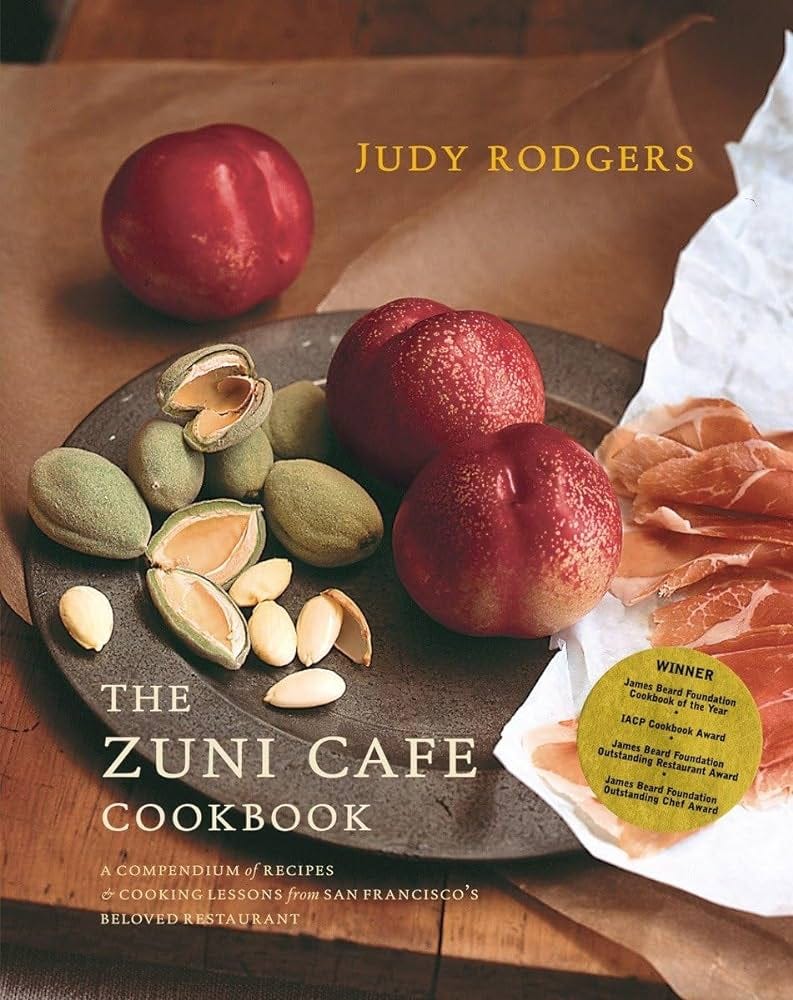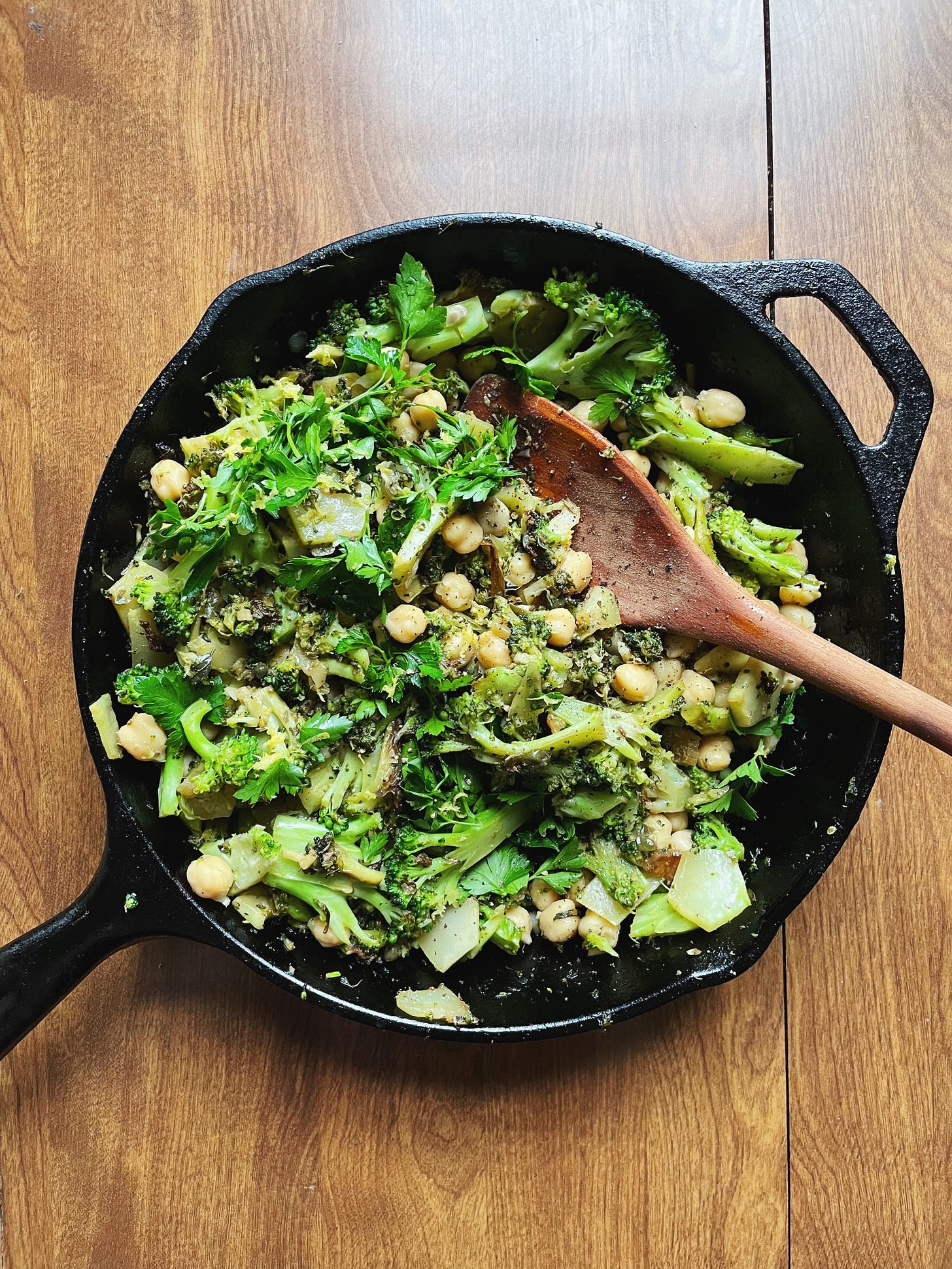One of the cookbooks I find myself returning to year after year is the Zuni Café Cookbook, written by Judy Rodgers. It is a hefty thing, over 500 pages. It has the word compendium on the cover, below an elegant, very late-90s still life: atop a rustic wood table sits a metal plate, and the metal plate holds two plums—they must be plums—and a few green almonds—this is San Francisco, after all—and a few of the almonds are open, splayed out for you, baring their fruit. Stretching onto the plate from outside the frame is a bit of sliced prosciutto on butcher paper, as if the meat were lazily reaching for some fruit. Somewhere in the back, out of frame, a curl of parchment, a third plum. I’ve always loved this cover, its timeless composition but conceptual datedness. Whenever I want to reject modernity and embrace tradition—bear with me here and let’s say that 20 years ago counts as tradition—I reach for Judy.
Zuni Café is a San Francisco restaurant run for a long time by Rodgers, who died in 2013. She’s most famous, I think, for her roast chicken and bread salad1—a dish I am always misremembering. I tend to think that she cooks her chicken atop cubed bread, which is always a delicious choice, but it’s far more complicated than that, somewhere between the terrain of a cheffy chef and a choosy home cook. You marinate, then toast, then bake the pieces of bread, then you toss them in chicken juices. Of course.
Alicia Kennedy recently wrote about the loss of “rigorous text-based instructions” in many modern cookbooks, about her desire for thoroughly written recipes. The Zuni Café book, I think, is a great example of this rigor. Many of the recipes are simple, or at the very least rustic, but Rodgers leaves no logistical stone unturned. Hence all that fussing with the bread.
One of my favorite and most-cooked recipes in the book is Pasta with Spicy Broccoli and Cauliflower. Actually, no—something I love about the book is the way the recipe titles are formatted, so it’s more accurate to say the recipe’s name is PASTA with SPICY BROCCOLI & CAULIFLOWER. The ampersand is italicized and basically filigreed. So is the broccoli, frizzled at the edges and bumped up to eleven with capers, garlic, chile flakes, anchovy, olives, fennel seeds, and an optional handful of breadcrumbs. If you were ever going to call a pasta dish sumptuous you might do it here.
All you’re basically doing in this dish is slicing broccoli (and/or cauliflower) thin, cooking it in oil, then adding all your salty and savory bits in layers until everything is shrunken and savory and a mix of crispy and chewy, then mixing it into your pasta. But Rodgers is exacting in her specifications: first you add the broccoli, cook for three minutes, then salt, then add the capers, then cook until everything is reduced by a third, and then the party really starts, everything else goes into the pan. She’s right, of course: the broccoli is a mix of brown and crisp-tender, the capers are fried, the garlic never burns. I always add a squeeze of lemon and some zest at the end, with all due respect.
Recently I was wondering what if you took the pasta out, no offense to pasta of course, it is my lifeline, but sometimes I simply do not want pasta again. Sometimes you’re three pasta dinners into the week and you’d like a break. Fully removing the pasta would make the dish a little heavy—there’s a lot of oil here, a lot of salty things, the vegetables need an infrastructural element to cling to. (Removed from pasta, the dish begins to remind me of Roy Finamore’s Broccoli Cooked Forever, with more texture and more bells and whistles2.) And so I began thinking of a warm salad, a use for the canned chickpeas on my shelf, something sturdy and brash but still lunch-appropriate. The resulting salad would be great with that whole crusty bread-softened butter song and dance for dinner, a glass of wine, yadda yadda. I’ve never been particularly interested in the idea of a “spoon salad”—there’s something depressingly midtown-lunch-rush about it—but I’ve been eating this with a soup spoon, the big beautiful faux-silver kind, and it’s working.
Yesterday I thought maybe I could outsmart Judy, and simplify the recipe. I thought maybe I could just roast the broccoli, then mix all the other stuff into a dressing at the end, add it in the last few minutes of cooking, save myself all that stirring. Shorter instructions, a gesture towards efficiency. But Judy had the last laugh. The dish is far better cooked in a pan: greener, more textural variation, you remember the difference between a cooked caper and a raw caper. It’s work but it’s not that much work. And it would make a wonderful room-temperature addition to any chilly-day-springtime potlucks.
Warm Chickpea-Broccoli Salad a la Zuni
Serves 4, adapted from the Zuni Café Cookbook
One large head of broccoli, about 1.5 pounds (or use cauliflower, or a mix)
About 2/3 cup mild tasting olive oil
Salt
1 generous tablespoon capers, rinsed, pressed dry between towels, and slightly chopped
4-6 anchovies
6 small (or 2-3 large) garlic cloves, coarsely chopped
1 teaspoon fennel seeds, lightly pounded in a mortar or cracked with a knife
4 to 8 pinches dried chile flakes
1 handful parsley, roughly chopped
A few tablespoons coarsely chopped black olives (optional)
1 can chickpeas, rinsed and drained
Zest and juice of 1 big juicy lemon
Trim the broccoli, leaving a few inches of stem intact. Slice the broccoli about 1/8 inch thick, and generally lengthwise. Most of the slices will break apart as you produce them, yielding a pile of smooth stem pieces, tiny green broccoli buds, and a few delicate slabs with stem and flower both. Don’t worry if the slices are of uneven thickness; that will make for more textural variety.
Warm about 1/4 cup of the oil in a 12-inch skillet over medium heat. (MB note: if your skillet is smaller, cook your broccoli in 2 batches.) Add most of the sliced broccoli, conveniently leaving the smallest bits behind on the cutting board for the moment. (They’ll burn if you add them too soon.) The oil should sizzle quietly. Swirl the pan, and leave the vegetables to cook until you see the edge bits browning, about 3 minutes. Salt very lightly adn toss or stir and fold gently. Add a few more spoonfuls of oil and scrape the remaining bits of broccoli into the pan. (If you’re cooking in batches, swap them out here.) Add the capers and swirl gently. Continue cooking over medium heat until the edges begin to brown, another few minutes, then give the pan another stir or toss. Don’t stir too soon or too often, or you will get a homogenous, steamy pile of vegetables instead of a crispy, chewy one. Most of the capers and vegetable crumbs will shrink into crispy confetti-like bits.
Once the mass of broccoli has shrunken by about one third and is largely tender, reduce the heat, add another few spoonfuls of oil, and scatter the chopped anchovy, garlic, fennel, and chili over all. Give the vegetables a stir or toss to distribute. Cook for another few minutes, then add the parsley, chickpeas, and olives if using. Add the lemon zest and juice. Taste for salt, and add a pinch if needed.
Reading this recipe page on Food & Wine, I’m struck by Rodgers’ note that she put the chicken on the menu to make use of the restaurant’s brick oven, at a time when people weren’t really ordering chicken at restaurants, because it was so prevalent in home kitchens at the time. I think we can trace the ubiquity of roast chicken on today’s restaurant menus back to the Zuni oven.
It also reminds me of my favorite zucchini recipe, in the way that you cook the vegetables until they’re almost perfect, and then add all the flavorful bits.






What a great post. I thought the Zuni Cafe book would be another “Greens” restaurant cookbook tale. Boy was I wrong.
We’re going to try the broccoli salad this weekend as part of the dinner we’re hoisting to celebrate our daughter’s graduation!
another great post, Marian. I'm your biggest fan in all of Tennessee!